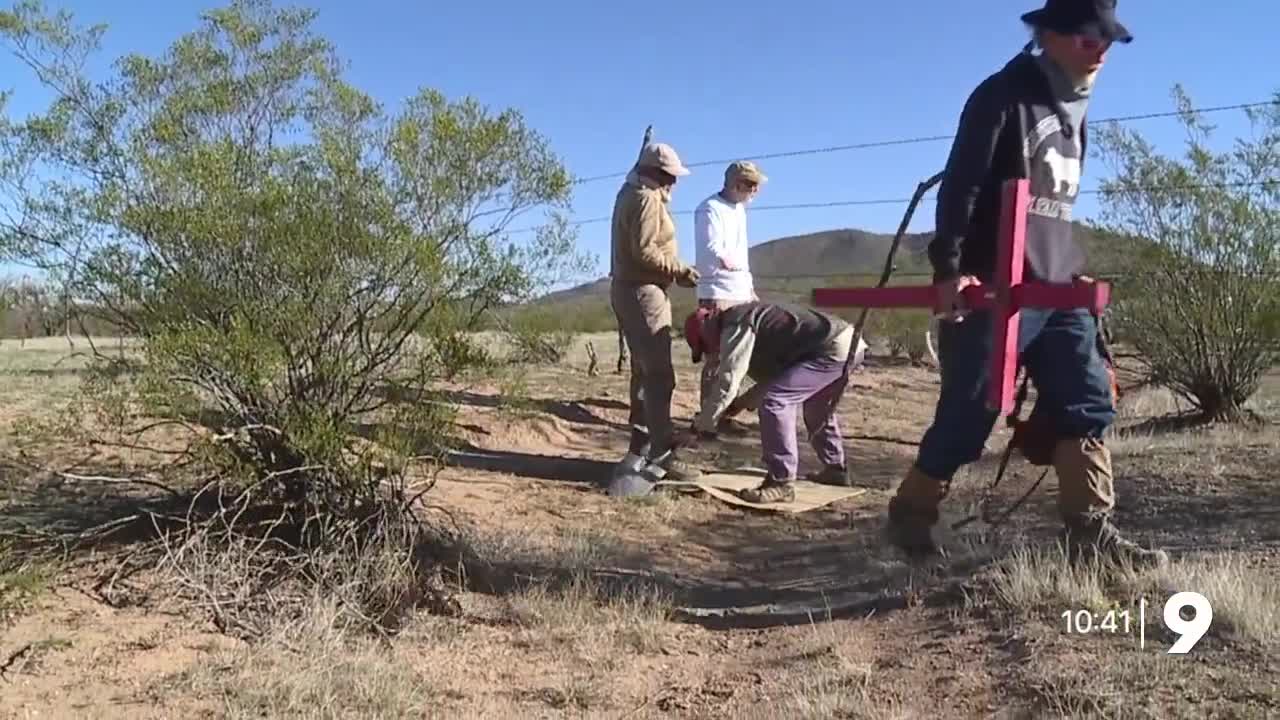TUCSON, Ariz. (KGUN) — Since 2000, nearly 4,000 migrant remains have been found in Southern Arizona. During the 2022 federal fiscal year, 179 bodies were recovered.
Alvaro Enciso is an artist with the nonprofit Tucson Samaritans. He makes wooden crosses and places them where bodies have been found.
“You know, out of the 4,000 people that have been found dead here, about ⅓ of them are unidentified,” said Enciso.
He’s determined to place a cross at every location a body has been found.
“I have put about 1,500 crosses so far in 10 years. I work slowly,” he said.
Enciso takes a trip every Tuesday to the Southern Arizona desert to place at least three crosses each time.
“So these crosses that I put every week are sort of the story of my own life, you know I came here as a migrant. So I decided to mark these locations where the American dream came to an end,” said Enciso.
He places each cross in a hole he digs, and then fills it with concrete and rocks. After all is set in stone, the Tucson Samaritan volunteers lay a rosary and pay their respects.
Then they hike back to the car to drive to the GPS marker where the next body was found.
“When a migrant is found dead out in the desert, the first thing that you do is you call 9-1-1. And 9-1-1 will send a deputy to pick up the remains to send them to the medical examiner and part of the protocol for the remains is to put a GPS mark where the person is found.”
Every month the Pima County Medical Examiner's Office sends new information on migrant deaths to the nonprofit Humane Borders.
Humane Borders records that information on a map showing marked locations where remains have been found since 2000.
Around 2000 is when the number of deaths increased significantly. Pima County Medical Examiner Dr. Greg Hess describes the increase by calendar year.
“About 77 deaths in 2001, about 146 in 2002, and then ever since 2002 we’ve averaged 165 remains a year. And clearly it’s fluctuated over time.”
In the 2021 federal fiscal year, that number reached its peak.
”2021 we had a very busy June, it was very hot, very dry. In 2022 it was a little bit more moderate, we did get more rain last year. So really the biggest benchmark for the number of people dying, in my opinion, is weather related.”
In an effort to prevent deaths, the Tucson Samaritans set out water and other items that could possibly save a life.
“Humanitarian aid is never a crime. So we help people. We give them food, we give them water to not let them suffer, and if they want us to call border patrol, we do. And most of them do because they know they’re going to die,” said one volunteer, Gail Kocourek.
Gail Kocourek witnesses what goes on at the border twice a week. She remembers seeing and talking with many migrants who are often looking for a life line. There’s one encounter she said she will never forget.
“I found him along the side of the road, his arms were covered with scratches. He was from Guatemala, he just wanted to be with his sister in the south. And he kept saying that he wanted to be with her. But he didn’t have food, didn’t have water, he’d been left.”
She remembers getting a friend on the phone to translate. They translated that the man wanted her to call border patrol.
“When he realized that his dreams were gone, he sat down in the back of my car and put his head on my shoulder and cried. He was only 23, you know, and he just wanted to be with his family. It was so heartbreaking to have him crying, and the border patrol came and walked away with him, and as he walked away he was crying and he took his rosary off and put it around my neck. and it made me cry,” explained Kocourek.
She's seen a lot, from people crossing through openings to people climbing the wall. She said despite how hard it is to witness, she keeps going for a reason.
——-
Reyna Preciado is a reporter for KGUN 9, she joined the KGUN 9 team in July of 2022 after graduating Arizona State University. Share your story ideas with Reyna by emailing reyna.preciado@kgun9.com or by connecting on Instagram, or Twitter.




